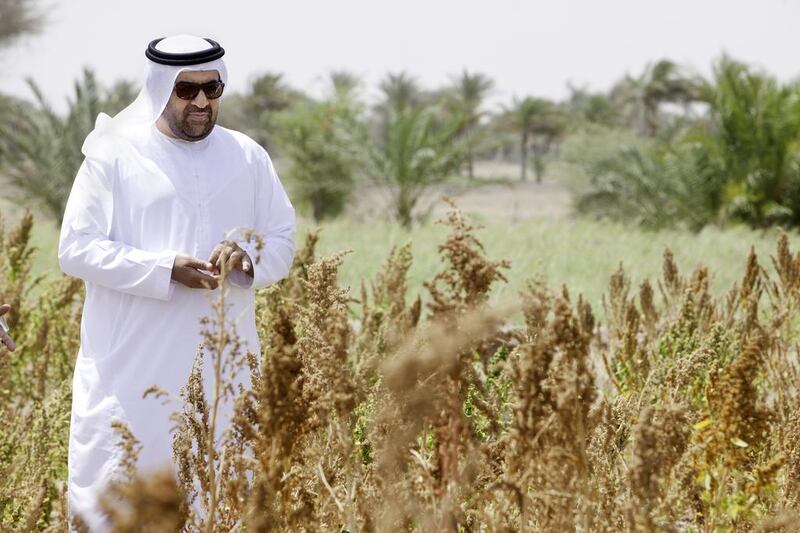ABU DHABI // Quinoa, the South American crop that has taken health food stores by storm in the past few years, could soon be commercially grown in the UAE.
The small crop was planted locally for the first time in December by three agriculture research centres under the umbrella of the Ministry of Environment and Water. After a promising harvest last month, officials hope to be able to persuade local farmers of the benefits of growing the crop.
“This is a very encouraging experiment and has very good potential,” said Dr Rashid bin Fahad, the Minister of Environment and Water, of the trial that saw experimental fields of quinoa in Ghayathi in the Western Region, in Dibbah, Ras Al Khaimah and Al Dhaid.
Of all the locations, the field in the Al Dhaid Experiments Station provided the best result with more than five tonnes per hectare. The yield, said Dr bin Fahad, “is even exceeding international figures”.
“This is a very encouraging result we are having and what we will do next is transfer this to farmers,” he said.
“Already farmers have interest to grow it and this could be feed for animals and could be also a good source of protein as food for humans.”
Although quinoa plants resemble a grass, they are actually related to beetroot and spinach. Typically grown in the Andes, the plant has been praised by experts for its ability to withstand a wide range of temperatures – from –0° C up into the high 30s.
Its recent spread in popularity as a health food is due to its high-protein content and the presence of important amino acids, minerals and vitamins.
The crop’s rise in popularity was reflected in an initiative by an United Nations agency to declare 2013 the international year of quinoa.
In the UAE, the trial was started in collaboration with the International Centre for Biosaline Agriculture in Dubai, and is part of efforts to ensure local food security, while also encouraging the cultivation of plants that can adapt well to the arid conditions of the country.
The plant has so far performed well, said Mohammed Mousa Abdullah, director of the agricultural research department at the ministry.
“We used a small quantity of fertiliser but we did not use pesticides,” he said.
Researchers will continue testing the crop’s growth under different temperatures and using water with various amounts of dissolved salts – an issue of particular importance in the UAE where a significant part of groundwater resources, which are mainly used for agriculture, have high salinity.
In Al Dhaid, groundwater of relatively low salinity was used to irrigate the quinoa fields, said Mr Abdullah. In his opinion, one of the reasons behind the good harvest achieved at Al Dhaid could have to do with the area’s dry climate.
Native to the highlands of Bolivia, the plant’s yield can be affected by humidity, he added.
“The best environment is dry and high land,” he said. “Al Dhaid is usually a dry area, one of the driest in the UAE, so this was why we got good results for the produce.”
Mr Abdullah said the ministry hopes to start a trial with selected farmers growing quinoa in commercial conditions.
The trial could start before the end of this year, he said.
“Many people, when we were growing, they visited to see and ask about it, as it is new in the region,” he said. “This crop is very well known in different countries around the world. I hope very soon, the UAE will adopt widely this crop.”
vtodorova@thenational.ae





